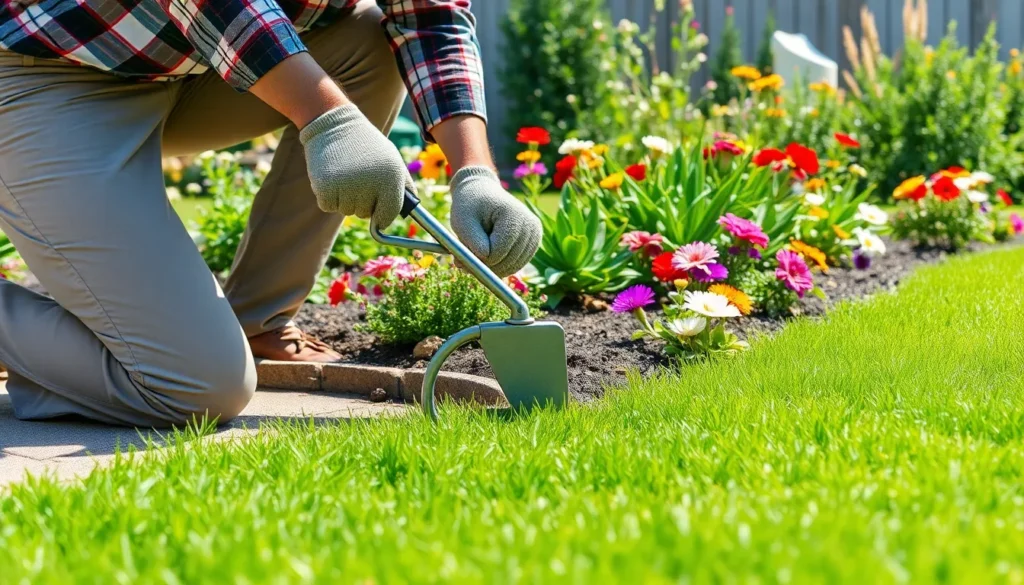A well-defined garden edge transforms any outdoor space from ordinary to extraordinary. We’ve all admired those picture-perfect landscapes where crisp lines separate vibrant flower beds from manicured lawns – and wondered how to achieve that professional look ourselves.
The secret lies in choosing the right edging solution for your exact needs and style preferences. Whether you’re working with a tight budget or ready to invest in premium materials we’ll explore creative approaches that deliver stunning results. From natural stone borders to modern metal strips each option offers unique benefits for different garden styles and maintenance requirements.
Creating clean garden edges doesn’t require professional landscaping skills. With the right materials and techniques you can establish beautiful boundaries that enhance your garden’s visual impact while reducing maintenance headaches. Let’s jump into proven edging ideas that’ll elevate your industry design.
Manual Garden Edger Ideas for Precise Control
Manual edging tools offer complete control over every cut and trim in your garden borders. We prefer these tools when working around delicate plants or creating intricate curved edges that require careful attention.
Half-Moon Edging Spades
Half-moon spades deliver the most versatile solution for creating clean garden edges with manual precision. We recommend these curved blade tools for cutting through thick grass roots and establishing new border lines with minimal effort.
Professional landscapers favor half-moon spades because they slice through tough sod like a hot knife through butter. The curved design allows us to rock the tool back and forth, creating smooth continuous lines without the choppy appearance that straight spades often produce.
Blade width typically ranges from 4 to 6 inches, giving us options for different edging tasks. Narrow blades work perfectly for tight curves around flower beds, while wider versions excel at creating long straight borders along walkways and driveways.
Handle length affects our leverage and comfort during extended edging sessions. Short handled models around 28 inches provide better control for detailed work, whereas longer 36 inch handles reduce back strain when edging large areas.
Rotary Hand Edgers
Rotary edgers offer effortless cutting action through their rolling wheel design that slices grass with each forward motion. We find these tools particularly effective for maintaining existing edges and creating consistent depths along established borders.
Star wheel configurations create the cleanest cuts by penetrating soil and grass roots simultaneously. The multiple cutting points distribute pressure evenly, preventing the tool from getting stuck in dense turf or clay soil conditions.
Adjustable cutting depths let us customize the edge profile based on our exact needs. Settings typically range from 1 to 3 inches deep, allowing shallow decorative lines or deeper permanent boundaries that discourage grass encroachment.
Ergonomic handles reduce hand fatigue during repetitive rolling motions. We prefer models with cushioned grips and proper weight distribution that prevent wrist strain when working on longer border sections.
Long-Handle Edging Shears
Long-handle shears provide standing height precision for trimming grass edges without kneeling or bending. We use these tools for finishing touches after primary edging work and maintaining areas where mechanical edgers can’t reach.
Blade angles optimize cutting efficiency when positioned at ground level. The best models feature blades set at 90 degrees to the handles, ensuring clean cuts parallel to existing borders without awkward wrist positioning.
Cutting blade length affects our reach and maneuverability around obstacles like fence posts or garden ornaments. Standard 6 inch blades handle most residential edging tasks, while 8 inch versions cover more ground with each cut.
Spring loaded mechanisms reduce the effort required for repetitive cutting motions. These assist features help us maintain consistent pressure throughout long edging sessions, resulting in uniform grass height along our garden borders.
Electric Garden Edger Ideas for Efficient Landscaping
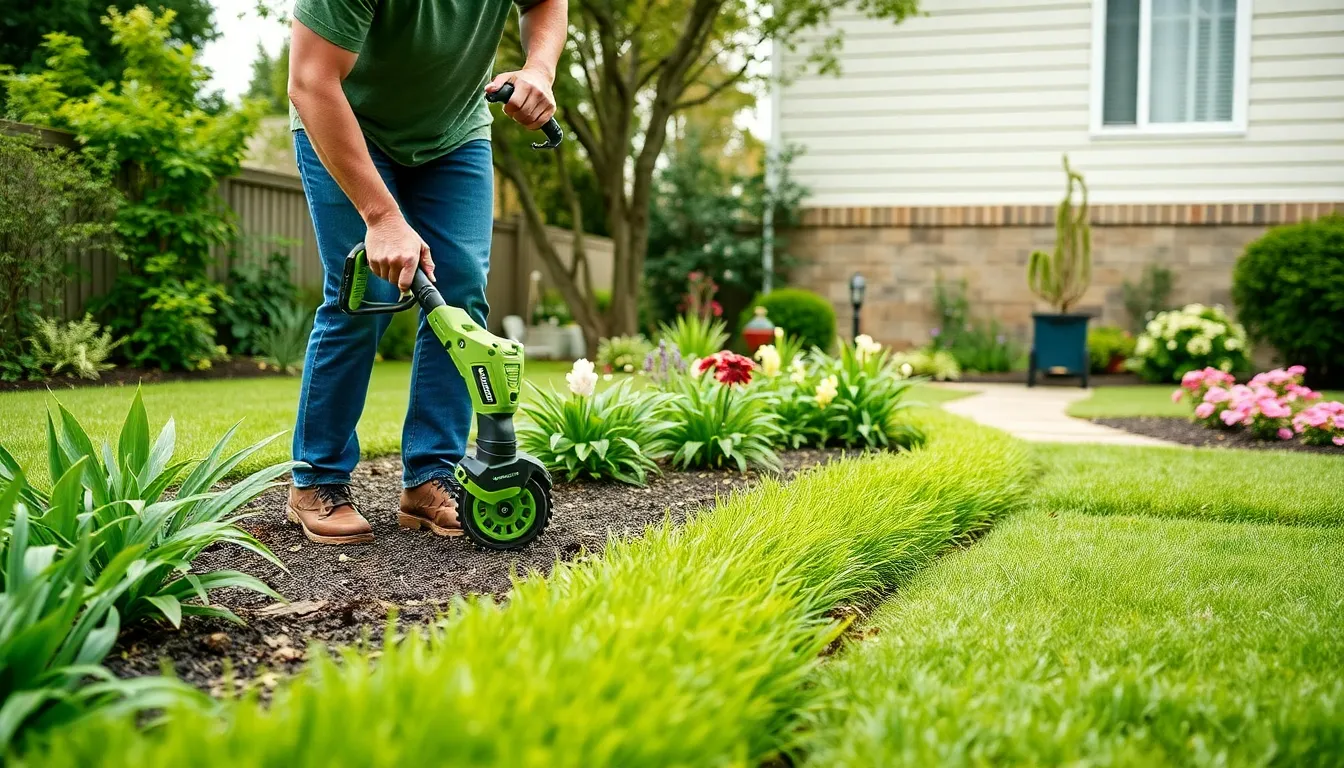
Electric edgers bring power and precision to your garden maintenance routine. These tools eliminate the physical strain of manual edging while delivering professional results that transform your industry’s appearance.
Corded Electric Edgers
Corded electric edgers deliver consistent power output for medium sized residential properties. These reliable tools plug directly into standard outlets and maintain steady performance throughout your entire edging session without power fluctuations or battery concerns.
Budget conscious homeowners find corded models particularly appealing since they typically cost less than battery powered alternatives. You’ll get dependable cutting power for flower bed borders, walkway edges, and driveway lines without the ongoing expense of replacement batteries.
Mobility limitations present the main consideration with corded electric edgers. Extension cords restrict your working radius from power sources, and you’ll need to manage cord placement to avoid tangling or accidentally cutting through the power cable during operation.
Battery-Powered Edgers
Battery powered edgers revolutionize garden maintenance with unrestricted mobility throughout your property. Modern lithium ion technology provides impressive runtime and consistent power delivery that rivals corded alternatives.
Greenworks 60V Cordless Edger stands out for its lightweight construction and extended battery performance across various yard sizes. The tool’s ergonomic design reduces user fatigue during longer edging sessions while maintaining precise cutting control.
EGO POWER+ ME0801 56 Volt Cordless Edger offers professional grade performance with rapid charging capabilities and interchangeable battery systems. Users appreciate the tool’s durability and consistent cutting depth adjustment features for customized edge profiles.
Convenience factors make battery edgers ideal for properties with multiple garden areas or limited electrical outlet access. You can edge remote sections of your industry without dragging extension cords or worrying about power source proximity.
Electric Grass Trimmers with Edging Attachments
Electric grass trimmers with edging attachments provide versatile functionality in single tool packages. These multi purpose instruments switch between string trimming and precision edging tasks using interchangeable cutting heads.
Space efficient storage becomes a major advantage since one tool replaces multiple specialized implements in your garden shed. The economic benefits extend beyond initial purchase price through reduced maintenance costs and simplified tool inventory management.
Interchangeable head systems allow quick transitions between different cutting applications during single work sessions. You can trim grass around obstacles then immediately switch to edging mode for crisp border definition without returning to storage for separate tools.
Performance versatility makes these combination tools particularly valuable for smaller properties where storage space is limited. The ability to handle both trimming and edging tasks with consistent power delivery streamlines your entire lawn care routine.
Gas-Powered Garden Edger Ideas for Heavy-Duty Work
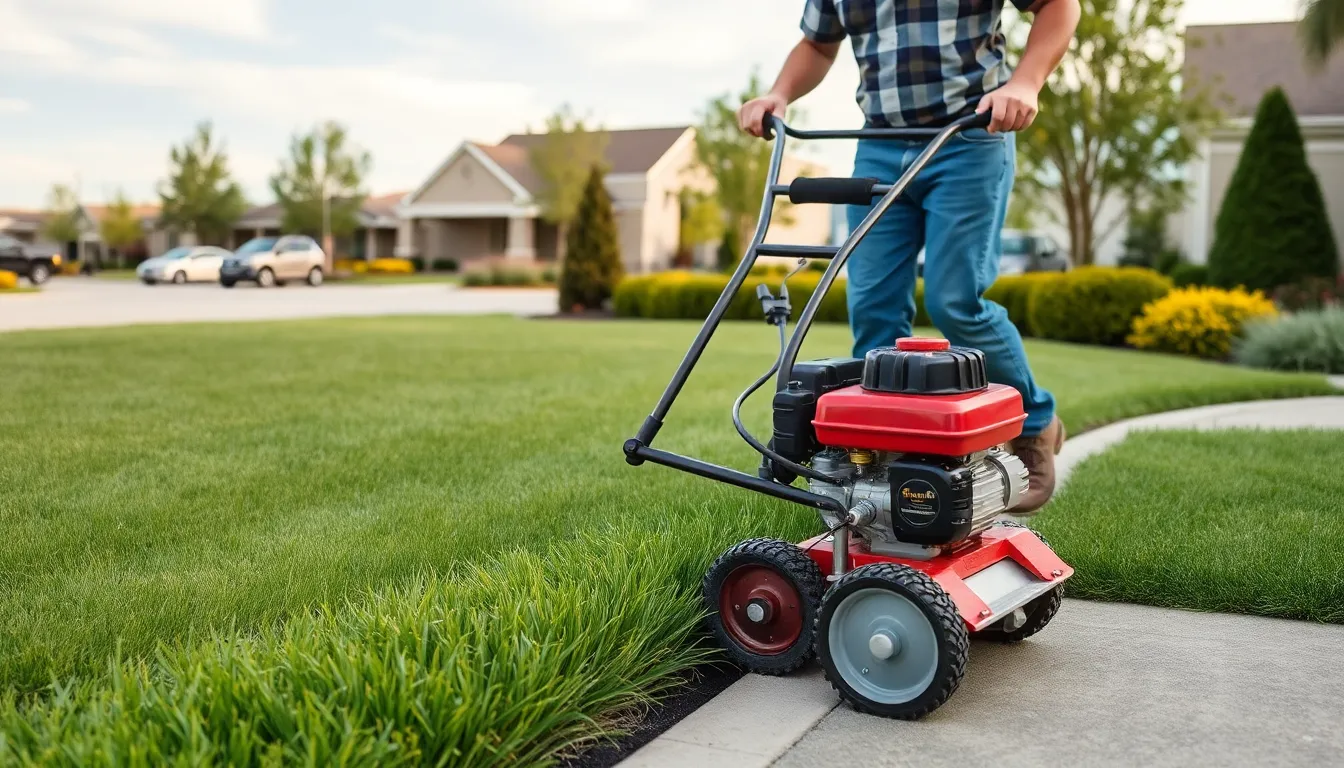
Gas-powered edgers deliver the raw power needed for tackling extensive landscaping projects and challenging terrain. These robust machines excel where electric models fall short, offering sustained performance for professional-grade results.
Walk-Behind Gas Edgers
Walk-behind gas edgers dominate large-scale edging projects with their superior power and efficiency. These heavy-duty machines feature adjustable cutting depths that accommodate various soil conditions and edge requirements.
Professional landscapers rely on these units for their ability to handle extensive lawn maintenance without fatigue. The robust design includes powerful engines measured in horsepower (hp) and cubic centimeters (cc), with higher ratings delivering more cutting force through tough sod and compacted soil.
Commercial properties benefit from the consistent performance these edgers provide across vast areas. Self-propelled models reduce operator strain while maintaining precise control over cutting depth and speed.
Handheld Gas-Powered Edgers
Handheld gas edgers combine portability with impressive cutting power for detailed landscaping work. These lightweight units excel in tight spaces around gardens and flower beds where larger equipment can’t reach.
Maneuverability becomes effortless with these portable powerhouses that deliver gas engine strength without the bulk. The compact design allows operators to create precise edges along curved pathways and intricate garden borders.
Versatility shines through their ability to handle both straight cuts and complex angles with equal precision. Engine specifications typically range from 25cc to 35cc, providing ample power for residential and light commercial applications.
Multi-Tool Gas Systems with Edging Attachments
Multi-tool gas systems revolutionize equipment efficiency by offering multiple landscaping functions with a single powerful engine. These versatile platforms accept various attachments including edger heads, trimmers, and pruning tools.
Cost effectiveness emerges as users eliminate the need for separate engines across different maintenance tasks. The interchangeable attachment system allows quick transitions between edging, trimming, and pruning without engine downtime.
Storage answers become simplified as one power unit serves multiple landscaping needs. Professional contractors appreciate the reduced equipment investment while maintaining full functionality across diverse job requirements.
| Engine Specifications | Power Range | Best Application |
|---|---|---|
| Walk-Behind Models | 3-5 hp | Large commercial properties |
| Handheld Units | 25-35 cc | Residential detail work |
| Multi-Tool Systems | 30-50 cc | Versatile property maintenance |
Blade selection impacts cutting performance significantly across all gas-powered edgers. Flat rectangular blades handle standard edging tasks, while scoop-cut edge blades create cleaner finished lines. Star-shaped blades excel in breaking through established turf and creating new edge boundaries.
Creative DIY Garden Edger Ideas Using Household Items
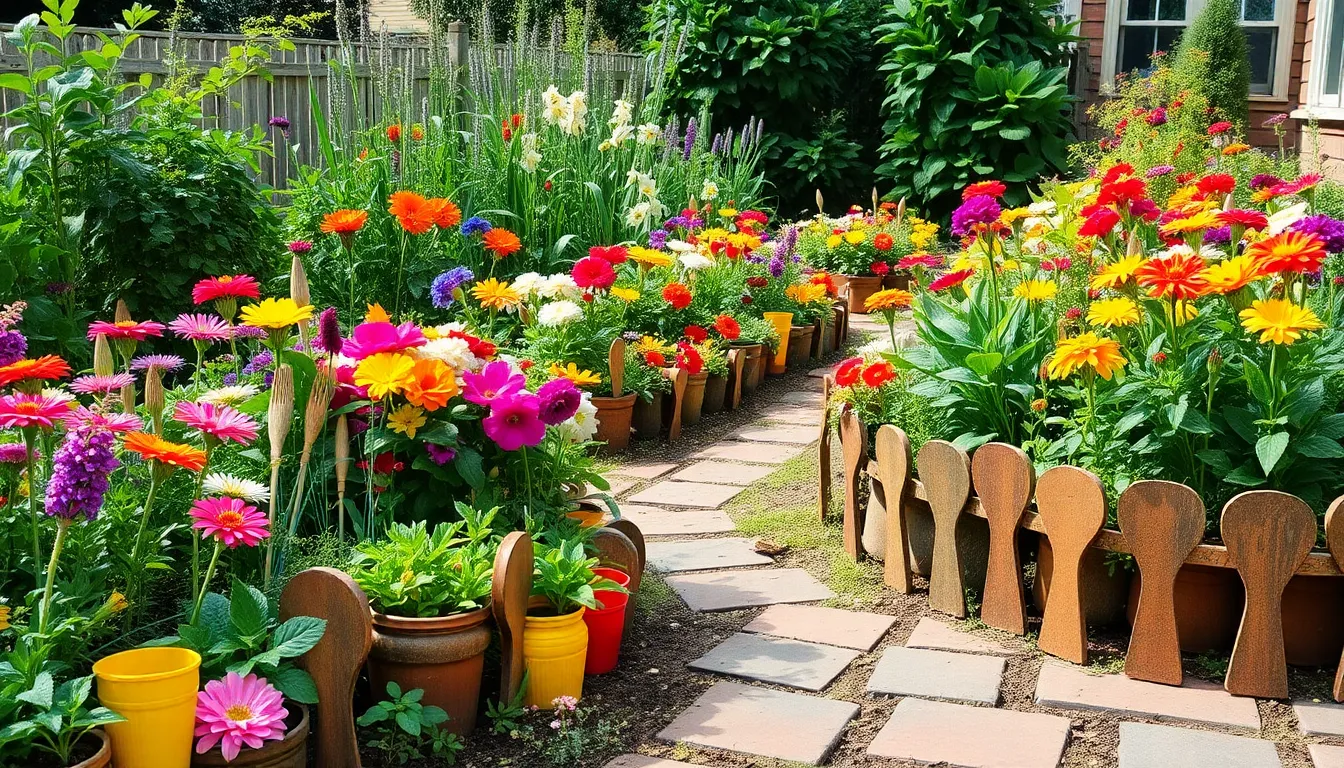
We can transform ordinary household items into stunning garden borders that rival expensive store-bought options. Our creative approach helps save money while adding unique personality to garden spaces.
Repurposed Kitchen Tools
Old pots and pans create whimsical garden borders that showcase our eco-friendly mindset. We arrange these kitchen classics along flower bed edges for instant character that sparks conversation among visitors. Kitchen utensils like wooden spoons and spatulas add rustic charm when we position them vertically along garden pathways. Large serving bowls work beautifully as planters within our edging design, creating layered visual interest that enhances the overall garden aesthetic.
Colanders and strainers offer unique drainage answers when we embed them partially into the soil as decorative border elements. Cookie sheets can be bent and shaped to follow curved garden lines, providing flexible edging options that adapt to our industry’s natural contours.
Modified Garden Tools
Railroad ties transform into robust rustic borders that withstand harsh weather conditions and heavy foot traffic. We position these repurposed materials to create defined garden boundaries that last for decades with minimal maintenance. Industry timbers provide natural wood aesthetics while delivering structural support for raised bed gardens and sloped terrain areas.
Old garden hoses become flexible edging answers when we secure them along curved pathways and flower bed perimeters. Broken tool handles find new life as decorative stakes that we paint in coordinating colors to match our garden’s color scheme. Wire tomato cages can be flattened and reshaped into custom edging forms that follow our garden’s unique layout requirements.
Homemade Wooden Edging Guides
2x4s and 4x4s create simple yet effective garden bed frames that we secure using construction adhesive for long-lasting results. We build these lumber frameworks to define planting areas while providing clean separation between lawn and garden spaces. Deck boards serve as finishing touches when we layer them over basic wooden frames, creating polished borders that complement outdoor living areas.
Fence pickets offer vertical edging options that we install at varying heights to create ever-changing visual rhythm along garden perimeters. Cedar planks resist rot and insects naturally, making them ideal choices when we construct permanent edging answers that require minimal replacement over time. Pallet wood provides cost-effective materials that we disassemble and repurpose into custom edging designs that reflect our personal style preferences.
Natural Garden Edger Ideas for Eco-Friendly Borders

We’re shifting our focus to sustainable edging answers that work harmoniously with nature while creating stunning garden boundaries. These eco-friendly options reduce environmental impact while providing lasting beauty and functionality.
Stone and Rock Edging
Classic stone edging delivers timeless appeal that complements any garden style seamlessly. We recommend Techo-Bloc’s Rocka edging for its classic appearance and minimal maintenance requirements, making it an ideal choice for busy gardeners.
River rocks and pebbles create relaxed garden atmospheres perfect for reducing formality in manicured spaces. Combining large river rocks with smaller pebbles adds fresh visual interest while maintaining natural aesthetics that blend with existing landscapes.
Gabion walls offer dual functionality by creating natural barriers that keep animals away from garden beds. These structures use rocks or pebbles contained within wire frameworks, providing both practical protection and attractive borders that enhance garden security.
Wooden Log Borders
Rustic wooden logs establish eco-friendly borders that perfectly suit natural or forest-themed gardens. Using logs in their natural state creates authentic woodland aesthetics, while seasoned wood enhances appearance and extends durability for long-term garden definition.
Split rail arrangements provide traditional charm when logs are positioned horizontally along garden perimeters. This approach works exceptionally well for cottage gardens and rural properties where natural materials enhance the overall industry design.
Living Plant Edges
Herb borders create fragrant and functional boundaries using plants like thyme or rosemary along garden edges. These aromatic borders provide dual benefits by defining spaces while offering fresh herbs for culinary use throughout the growing season.
Flower borders add vibrant color using low-growing varieties like petunias or violas that create stunning visual transitions. These flowering edges change seasonally, providing ever-changing interest that evolves throughout the year while maintaining clear garden definition.
Succulent borders offer low-maintenance answers that thrive in various conditions, making them perfect for water-wise gardens. These hardy plants require minimal care while providing year-round structure and unique textures that complement both modern and traditional industry designs.
Modern Garden Edger Ideas with Advanced Features
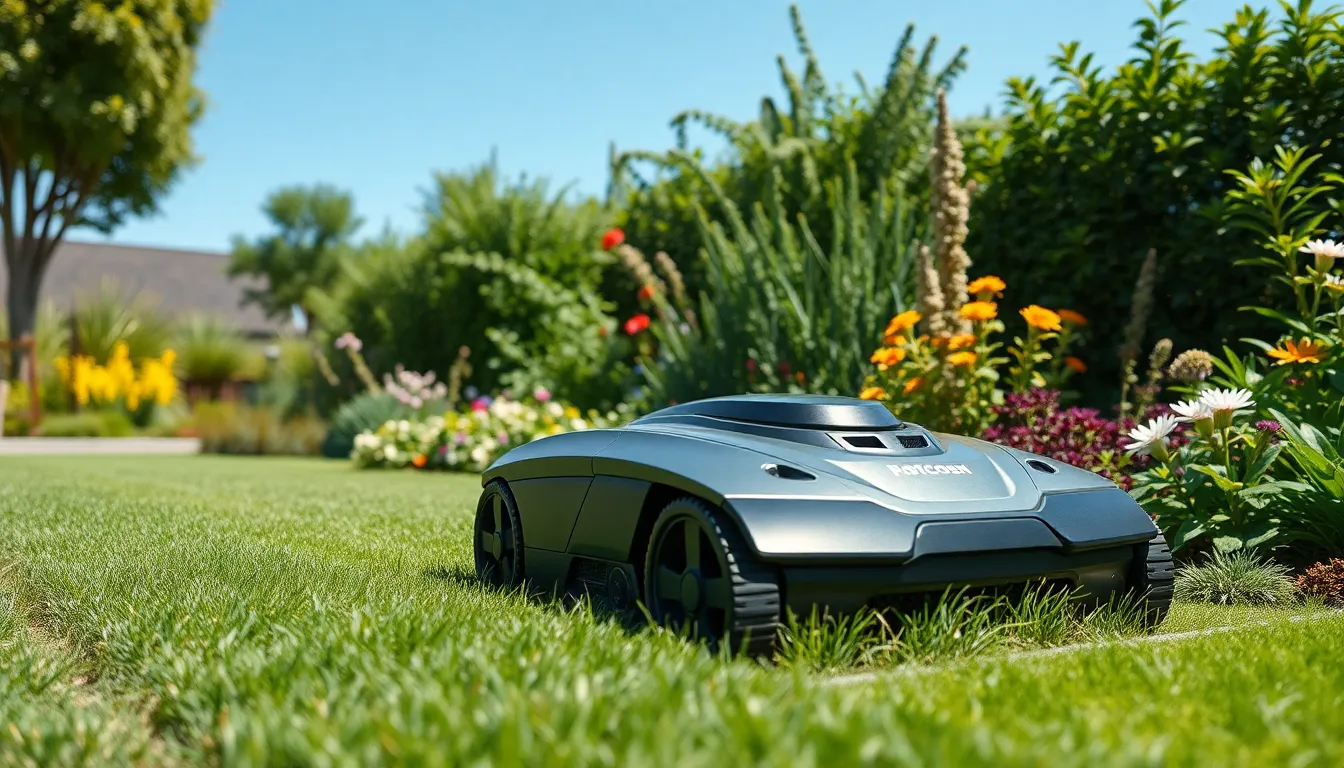
Technology continues to revolutionize garden maintenance, bringing us innovative edging answers that combine precision with convenience. We’re witnessing a new era where smart features transform traditional landscaping tools into sophisticated garden management systems.
Smart Electric Edgers with GPS
Smart electric edgers represent the cutting edge of precision gardening technology, though exact GPS integrated models remain limited in today’s market. These innovative tools promise to deliver accurate boundary detection that could eliminate guesswork from your edging projects.
Automatic navigation systems would ensure consistent edge lines throughout your property, creating professional results with minimal effort. Features like real time positioning could help you maintain perfectly straight borders and curved pathways. We anticipate these advanced edgers will soon include programmable patterns and memory functions to replicate your preferred edging styles across different garden sections.
Robotic Lawn Edgers
Robotic lawn edgers automate the tedious task of maintaining crisp garden boundaries while you focus on other landscaping priorities. Leading manufacturers like Husqvarna and Robomow have developed robotic systems that adapt their mowing technology for precise edge maintenance.
Obstacle detection sensors allow these autonomous devices to navigate around garden furniture, sprinkler heads, and decorative elements without human intervention. Programming capabilities let you schedule regular edging sessions during optimal weather conditions or when you’re away from home. These smart machines can maintain consistent edge quality across large properties while reducing your physical workload and time investment.
Battery powered operation eliminates the hassle of extension cords while providing hours of continuous edging performance. Many models include weather resistant designs that continue working through light rain and morning dew conditions.
Edgers with Interchangeable Heads
Edgers with interchangeable heads maximize your tool investment by transforming a single device into multiple landscaping answers. This versatile approach reduces storage requirements while providing specialized attachments for edging, trimming, and pruning tasks.
Quick release mechanisms allow you to switch between different blade types within seconds, adapting to various garden materials and cutting requirements. Steel blades handle tough grass and root systems, while plastic heads work perfectly for delicate plantings and decorative borders. Some systems include specialized attachments for trenching, cultivating, and even snow removal during winter months.
Tool compatibility across attachment types means you can expand your capabilities over time without purchasing entirely new equipment. We find these multi function systems particularly valuable for smaller properties where storage space is limited but landscaping demands remain diverse.
Budget-Friendly Garden Edger Ideas for Every Homeowner
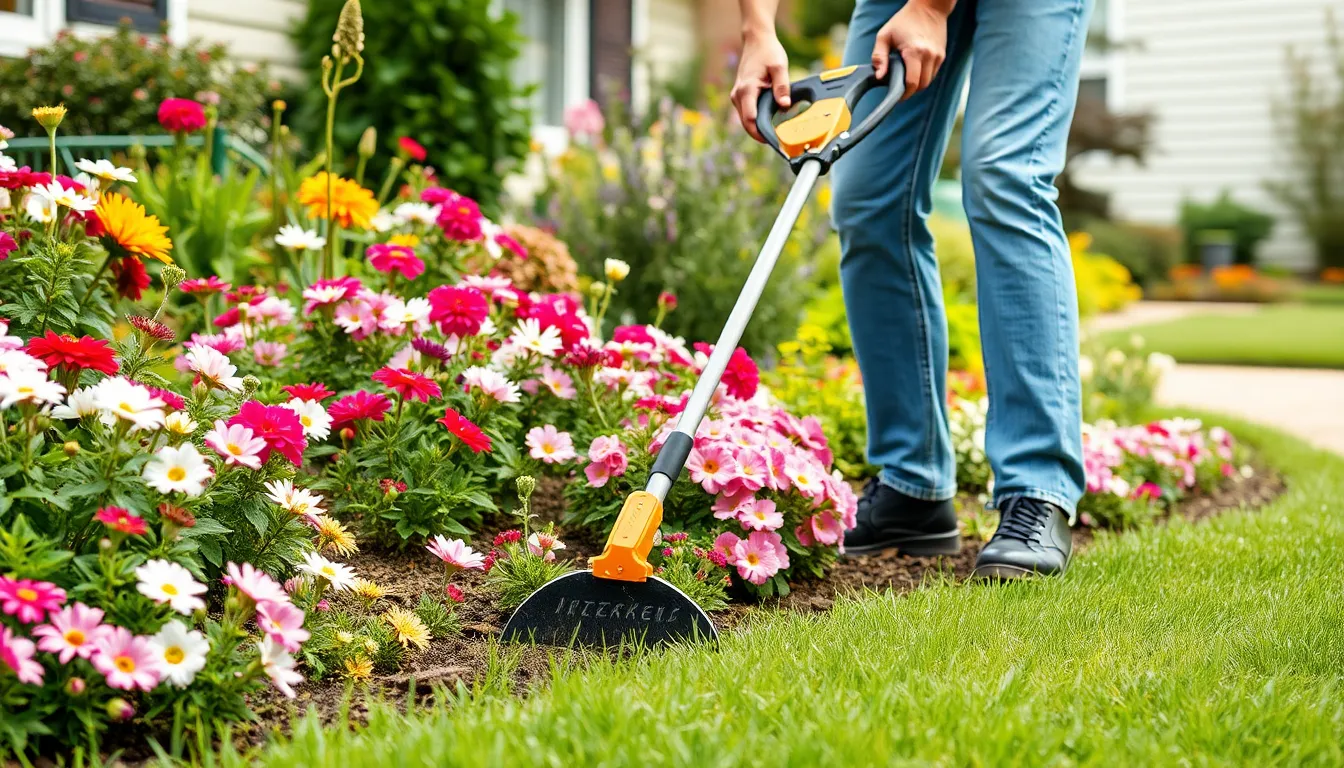
Creating beautiful garden edges doesn’t require a massive investment. We’ll explore affordable answers that deliver professional results without breaking your budget.
Basic Manual Options Under $25
Hand-held half moon edgers offer the most economical approach to garden edging, typically costing between $15-$25. These traditional tools feature a sharp, curved blade that cuts clean lines along walkways and flower beds with minimal effort.
Rotary wheel edgers provide excellent value at $12-$20 and work by rolling along your desired edge line. The rotating blade creates consistent depth while requiring less physical strain than traditional spades.
Long handle edging shears cost around $18-$25 and excel at trimming grass edges around delicate plants. Their extended reach eliminates the need for bending while delivering precise cuts in tight spaces.
Wood chip mulch borders represent one of the cheapest permanent answers, costing just $8-$15 per 50-foot section. This approach retains soil moisture while creating defined garden boundaries that complement natural landscaping.
Recycled material edging costs virtually nothing when using repurposed items like plastic bottles, wooden planks, or old bricks. These creative answers add personality to your garden while keeping materials out of landfills.
Gravel edging provides an attractive, low maintenance option for $10-$20 per linear foot. The stones create natural drainage while establishing clear boundaries between different garden areas.
Mid-Range Electric Models
Corded electric edgers in the $50-$100 range deliver consistent power for medium to large properties. These models feature adjustable cutting depths and ergonomic designs that reduce operator fatigue during extended use.
Battery powered edgers priced between $75-$150 offer the convenience of cordless operation without sacrificing performance. Modern lithium ion batteries provide 45-60 minutes of runtime on a single charge.
Electric grass trimmers with edging attachments cost $60-$120 and serve dual purposes in your garden maintenance routine. The pivoting head transforms from trimmer to edger with a simple adjustment.
Wheeled electric edgers ranging from $80-$140 include guide wheels that help maintain straight lines and consistent cutting depth. These models work particularly well for sidewalk and driveway edges.
Cost-Effective Maintenance Tips
Regular blade cleaning extends tool life by preventing rust and debris buildup after each use. Simply wipe metal surfaces with a damp cloth and apply light oil to moving parts monthly.
Proper storage practices protect your investment by keeping edgers in dry locations away from moisture. Hang tools on wall hooks or store in weatherproof containers to prevent damage.
Seasonal maintenance checks identify worn blades and loose connections before they cause problems. Replace dull cutting edges immediately to maintain clean, precise cuts.
Blade sharpening services cost $5-$10 at most hardware stores and restore cutting performance without buying new tools. Sharp blades require less effort and produce better results.
Battery care protocols for electric models include storing batteries at room temperature and charging them monthly during off seasons. Proper battery maintenance can double their usable lifespan.
Preventive lubrication of moving parts with lightweight machine oil keeps mechanisms operating smoothly. Apply lubricant to pivot points and adjustment mechanisms every few months.
Professional Garden Edger Ideas for Landscape Contractors
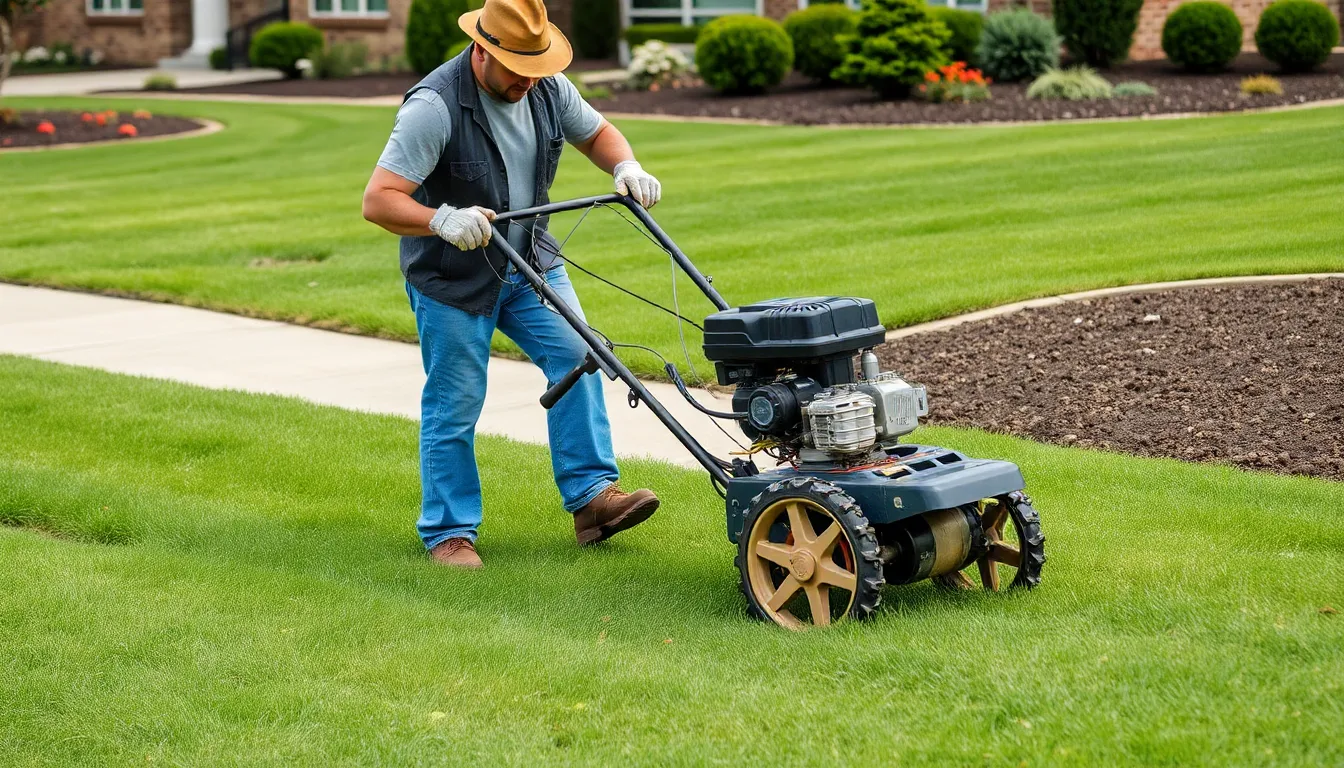
Professional landscapers need edging equipment that can handle demanding commercial workloads while delivering consistent results. We’ve researched the most effective answers that help contractors maximize efficiency and profitability across multiple job sites.
Commercial-Grade Walk-Behind Units
Self-propelled walk-behind edgers dominate commercial landscaping operations because they reduce operator fatigue during extensive edging tasks. The Turf Teq Power Edger stands out with its unique self-propelled, walk-forward design that’s specifically engineered for efficiency in large-scale landscaping projects.
Walk-behind units excel at maintaining consistent cutting depth across uneven terrain while allowing operators to cover substantial ground quickly. Professional landscapers prefer these models because they can handle continuous operation without compromising cut quality or requiring frequent maintenance breaks.
Commercial-grade construction ensures these edgers withstand daily use across multiple job sites. We find that investing in quality walk-behind units reduces equipment downtime and maintenance costs over time.
Truck-Mounted Edging Systems
Truck-mounted systems revolutionize large-scale commercial operations by eliminating the need to transport separate equipment between job sites. These comprehensive setups allow contractors to tackle extensive and complex edging tasks with professional-grade precision.
Commercial contractors rely on truck-mounted systems when managing multiple properties or large commercial developments. The integrated design streamlines workflow by keeping all necessary equipment organized and easily accessible.
Efficiency gains from truck-mounted systems become apparent when contractors need to complete multiple jobs throughout the day. We’ve observed important time savings when edging equipment travels seamlessly from one location to another.
Heavy-Duty Blade Options
Oscillating blade technology sets the Edge-R-Rite II Bed Edger apart from standard commercial edgers by reducing debris throw and increasing safety in high-traffic areas. This model offers six different blade options for various edging tasks, giving contractors versatility across different landscaping scenarios.
Generac edgers have earned recognition for their durability and versatility in commercial applications. These units feature customizable blade settings that enable precise cuts across different soil conditions and vegetation types.
Blade selection directly impacts cutting performance and equipment longevity in commercial settings. We recommend matching blade types to exact soil conditions and vegetation density to optimize results and extend equipment life.
Professional contractors benefit from having multiple blade options available because different properties require different cutting approaches. The ability to switch between specialized blades ensures consistent results across various landscaping challenges.
Specialized Garden Edger Ideas for Unique Situations
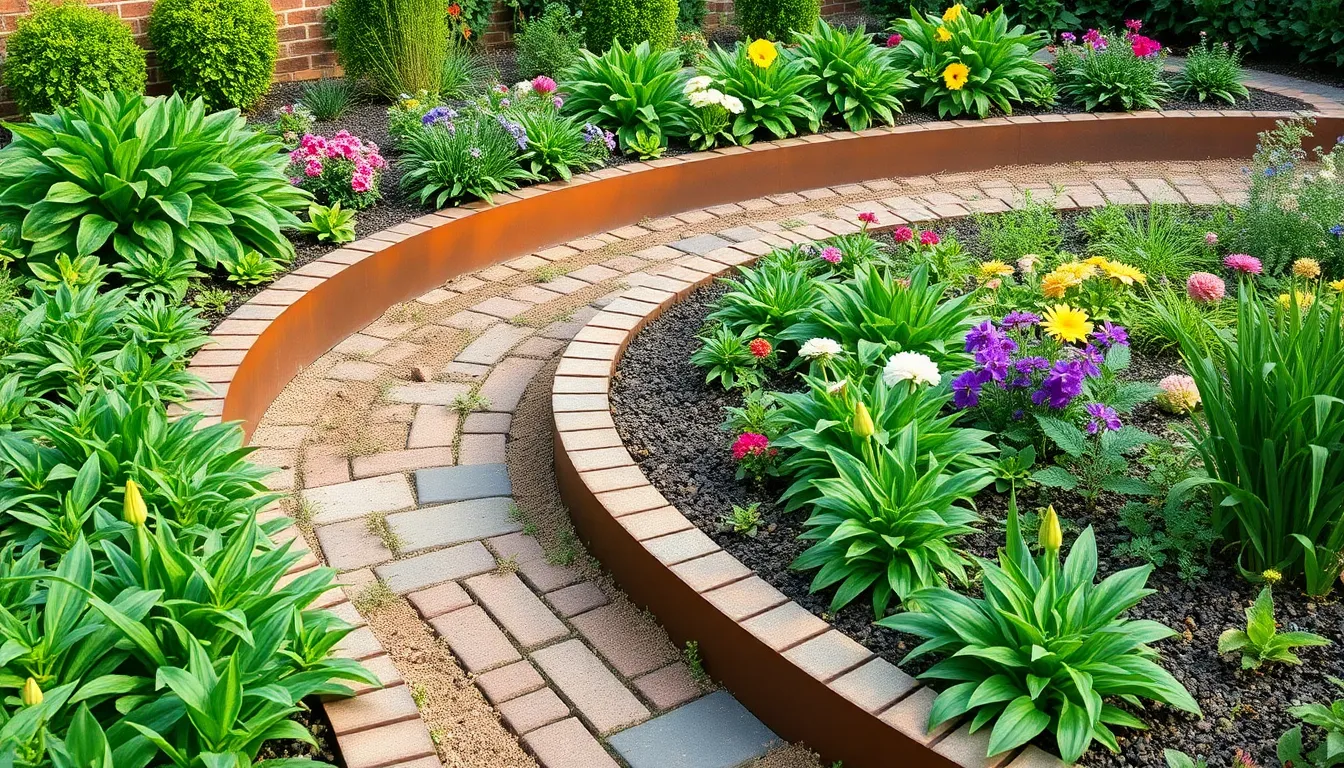
Gardens with unique layouts require specialized edging answers that address exact challenges while maintaining aesthetic appeal.
Curved Border Edgers
Corten steel edging transforms curved garden borders with its remarkable versatility and ability to bend into flowing shapes. We recommend this weathered steel material because it develops a beautiful rust patina over time that adds distinctive character to rounded garden sections. According to landscaping experts, corten steel offers exceptional durability while providing the flexibility needed for organic garden curves.
Concrete mold edging delivers custom curved answers that create sleek, polished boundaries around flower beds and walkways. We can shape concrete into virtually any curve while adding color pigments to match existing garden themes. This edging option provides permanent borders that resist weathering and maintain their appearance for decades.
Narrow Space Edging Tools
Metal edging excels in tight garden spaces where traditional tools can’t maneuver effectively due to its slim profile and commercial grade construction. We find metal edging particularly useful between narrow planting strips and walkways where space constraints limit other options. This material provides long lasting performance while maintaining clean lines in confined areas.
Composite edging combines wood fibers with recycled plastic to create durable borders that work perfectly in narrow garden sections. We appreciate how composite materials come in various colors that complement tight spaces without overwhelming the visual design. These eco friendly options resist rot and insect damage while requiring minimal maintenance in challenging locations.
Raised Bed Edging Answers
Timber edging remains our top choice for raised garden beds because of its traditional appearance and straightforward installation process. We recommend cedar or redwood varieties that naturally resist decay while providing rustic charm to vegetable gardens and flower beds. This classic material integrates seamlessly with organic garden designs and allows for easy height adjustments.
Brick edging creates sophisticated raised bed borders that can be stacked to form tiered planting areas with classic architectural appeal. We often use brick edging to establish different elevation levels within garden beds while maintaining consistent visual themes. This permanent solution provides excellent drainage and thermal mass benefits for plant root systems.
Composite edging adapts perfectly to raised bed applications where durability and low maintenance take priority over natural materials. We choose composite options for raised beds that require consistent height and resistance to soil moisture and temperature fluctuations.
Maintenance and Storage Ideas for Garden Edgers
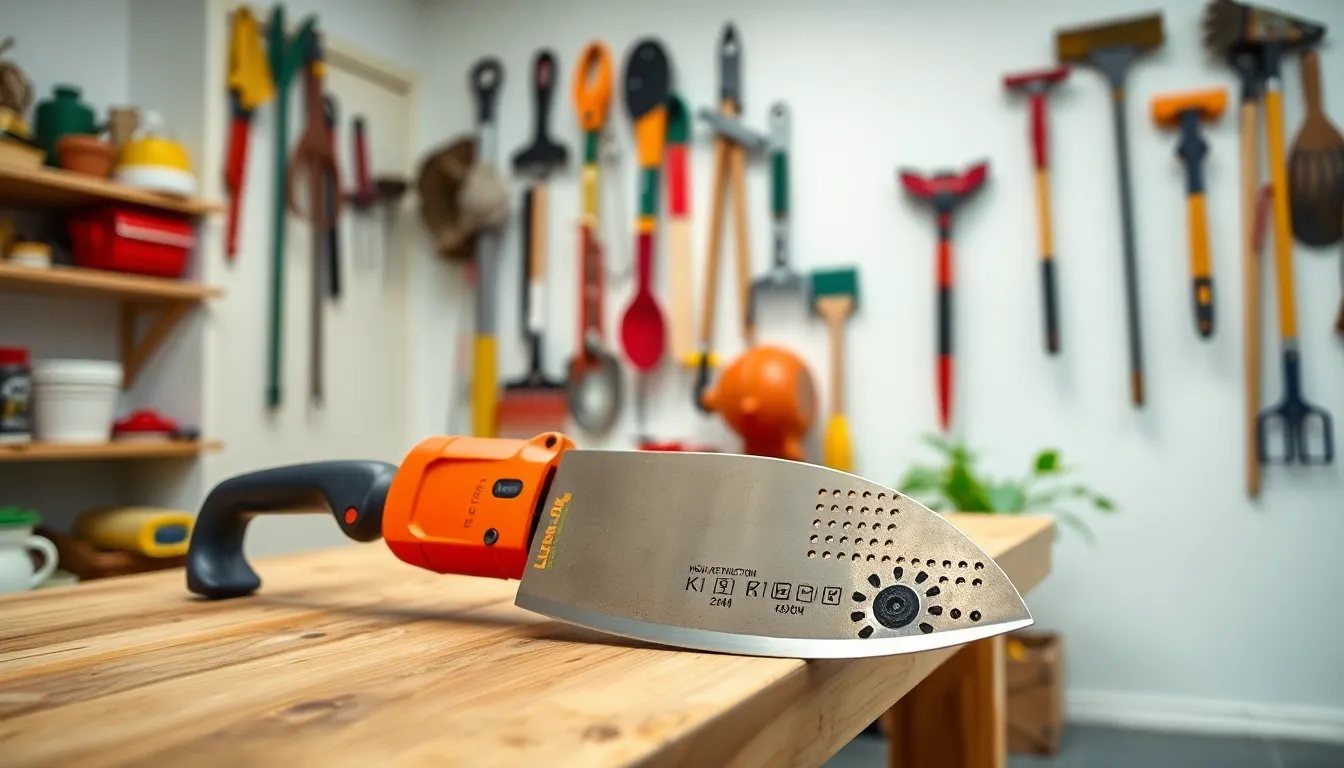
Proper maintenance and storage keep your garden edgers performing at their best while extending their lifespan significantly. We’ll explore essential techniques for cleaning, sharpening, and storing your edging equipment properly.
Proper Cleaning Techniques
Clean your edger after each use to prevent debris buildup that can damage internal components. Use a soft brush to remove dirt, grass clippings, and soil particles from the blade housing and engine areas.
Wipe down all surfaces with a damp cloth to eliminate moisture and residue that can lead to corrosion. Pay special attention to metal components that are prone to rust formation.
Check belts regularly for fraying or cracks during your cleaning routine, as a broken belt can render the edger completely inoperable. Replace damaged belts immediately to avoid unexpected breakdowns during use.
Remove stuck debris from air vents and cooling fins to ensure proper engine ventilation. Compressed air works effectively for clearing stubborn particles from hard to reach areas.
Blade Sharpening Methods
Use a file or sharpening stone specifically designed for edger blades to maintain optimal cutting performance. Sharp blades require less effort and create cleaner cuts through tough grass and soil.
Maintain consistent angles while sharpening to preserve the blade’s original geometry and effectiveness. Work in smooth, even strokes across the entire cutting edge.
Remove rust immediately when you notice it forming on blade surfaces. Fine steel wool or rust removal products restore the metal’s integrity and prevent further deterioration.
Test sharpness regularly by examining how cleanly the blade cuts through paper or thin cardboard. Dull blades tear rather than slice, indicating the need for immediate attention.
Storage Answers
Store garden edgers in dry, warm locations like heated garages or garden sheds to protect them from moisture and extreme temperature fluctuations. Cold, damp environments accelerate rust formation and damage rubber components.
Use wall mounted brackets or hooks to hang long handled tools vertically, maximizing available storage space in smaller areas. This approach keeps equipment organized and easily accessible.
Place frequently used equipment such as lawn mowers and edgers near the front of your storage area for convenient access during busy gardening seasons. Position heavier items on lower shelves to prevent lifting injuries.
Organize smaller tools using benches or labeled containers to maintain a tidy workspace. Group related items together to streamline your gardening workflow and reduce time spent searching for exact tools.
Inspect stored equipment regularly for signs of wear, damage, or pest intrusion that could compromise performance when you need it most.
Conclusion
We’ve explored dozens of garden edging answers that can transform your outdoor space from ordinary to extraordinary. Whether you’re working with a tight budget or have room for professional-grade equipment there’s an edging option that fits your needs perfectly.
The key is matching your tool choice to your exact situation. Manual edgers work beautifully for small precise jobs while electric and gas-powered options tackle larger properties with ease. Don’t overlook creative DIY answers either – they often deliver stunning results at fraction of the cost.
Remember that even the best edging tool won’t perform well without proper maintenance. Clean sharp blades and organized storage will keep your equipment working efficiently for years to come.
Your garden’s transformation starts with that first clean cut. Choose the edging approach that excites you most and begin creating those crisp professional-looking boundaries that make all the difference in your industry’s visual impact.
Frequently Asked Questions
What are the benefits of having well-defined garden edges?
Well-defined garden edges transform ordinary outdoor spaces into extraordinary ones by creating crisp, clean lines that separate flower beds from lawns. They enhance visual impact, reduce maintenance by preventing grass from growing into flower beds, and give your garden a professional, polished appearance that significantly boosts curb appeal.
Do I need professional skills to create clean garden edges?
No, creating clean garden edges doesn’t require professional landscaping skills. With the right materials, tools, and basic techniques, homeowners can achieve beautiful boundaries themselves. The key is choosing appropriate edging solutions based on your style preferences, budget, and the specific needs of your garden space.
What are the most affordable manual garden edger options?
The most budget-friendly manual options include hand-held half-moon edgers and rotary wheel edgers, typically available for under $25. These tools provide precise control and are perfect for small to medium-sized gardens. Long-handle edging shears are also cost-effective for maintaining existing edges and detailed work.
Should I choose electric or gas-powered garden edgers?
Electric edgers are ideal for residential use, offering efficiency and ease of maintenance with both corded and battery-powered options available. Gas-powered edgers provide more power for heavy-duty commercial work and larger properties. Consider your garden size, frequency of use, and power requirements when making your decision.
What creative DIY materials can I use for garden edging?
You can repurpose many household items into stunning garden borders, including old bricks, wine bottles, reclaimed wood, and decorative stones. These DIY solutions are budget-friendly and environmentally conscious while adding unique character to your garden design. River rocks, wooden logs, and living plant edges also create beautiful natural boundaries.
How do robotic garden edgers work?
Robotic lawn edgers use advanced technology including GPS for precise boundary detection and obstacle sensors for safe operation. These automated systems can be programmed to maintain crisp garden boundaries on schedule, reducing manual labor. They’re equipped with rechargeable batteries and can navigate around obstacles while delivering consistent results.
What maintenance do garden edgers require?
Regular maintenance includes cleaning debris after each use, keeping blades sharp for optimal cutting performance, and proper storage in dry conditions. Electric models need battery care and cord inspection, while gas-powered units require fuel system maintenance. Proper care significantly extends equipment lifespan and ensures consistent performance.
Which edging materials work best for curved borders?
Corten steel and concrete mold edging are excellent choices for creating elegant curved borders due to their flexibility and durability. These materials can bend smoothly around curves while maintaining structural integrity. Metal strips and composite edging also work well for curved designs and tight spaces.
Are there edging solutions for raised garden beds?
Yes, raised beds benefit from timber, brick, and composite edging options. Timber provides a natural, rustic appearance; brick offers classic durability and visual appeal; while composite materials provide low-maintenance, weather-resistant solutions. Each option offers distinct benefits in terms of aesthetics, longevity, and upkeep requirements.
What’s the difference between commercial and residential garden edgers?
Commercial edgers are built for heavy-duty use with more powerful engines, reinforced construction, and specialized features like truck-mounted systems for contractors. Residential edgers prioritize ease of use, lighter weight, and cost-effectiveness for typical homeowner needs. Professional equipment handles demanding workloads and uneven terrain more effectively.

